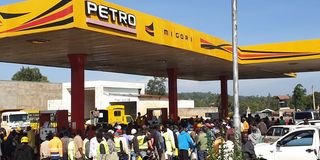Fuel cost: Brent crude price surge signals even tougher times ahead

Boda boda riders queue for fuel at Petro filling station, the only fueling point in Migori, on April 4, 2022.
Kenyans should brace themselves for tougher times ahead amid increasing global Brent crude oil prices even as the government prepares to pay oil marketing companies Sh13 billion in fuel subsidy arrears.
Yesterday, President Kenyatta signed into law the supplementary budget for the 2021/22 financial year, giving Sh34.4 billion to the Petroleum ministry for fuel stabilisation.
The allocation gives hope for the consumers that, while the state may not fully absorb the higher costs of fuel this month, the funds will keep the drying kitty going for a while longer.
Petroleum Principal Secretary Andrew Kamau in an interview with NTV on Sunday said the oil firms will be paid this week even as he strongly defended the sustainability of the fuel subsidy scheme.
The scheme has come under sharp criticism following delays by the government in releasing the funds to oil companies who resorted to exporting fuel while others could not afford to replenish their stocks, leading to the current shortage.

Motorists and boda boda riders wait at a filling station in Bomet County which ran out of fuel in the hope of being the first ones to be served once the outlet restocks.
Smarting from the biting fuel shortage that has already seen a sharp rise in fares in parts of the country, still higher fuel prices loom ahead of the monthly price review in 10 days.
Biggest beneficiaries
Official data seen by the Nation shows the top oil marketers have emerged the biggest beneficiaries of the ongoing scramble for fuel, giving a pointer to the motive of the shortage.
It shows the few large oil companies sold 20 million litres of fuel this weekend alone, nearly double what they normally sell.
One of the large oil marketers, for instance, sold 10 million litres of the product, which is half of the total volume of the product sold across the country during that time, and which is also more than double the about 4 million litres it usually sells over a typical weekend.

Stranded motorists at a filling station along the busy Nakuru-Eldoret highway, in Nakuru City on April, 4 2022 as the fuel shortage bites.
Last month, the Energy and Petroleum Regulatory Authority (Epra) increased petrol and diesel prices for the first time since September by Sh5 per litre, sending the cost of the products to a record high. This pushed the cost of the commodity to Sh134.72 per litre of petrol, Sh115.6 for diesel while that of kerosene, the least consumed fuel product, was retained at Sh103.54 for the sixth month. The price increase came just over two weeks since Russia invaded Ukraine, pushing international crude oil prices to a 14-year high following disruption of supply of the commodity.
The next review will be set on the average prices of the product imported into the country between March 9 and April 10, a period within which global Brent crude prices have far outstripped the import costs of the product currently being consumed.
This means the cost of fuel will be significantly higher unless the government dips into its pockets once again to stabilise prices as it did last month.
In the last review, the government partially applied the fuel subsidy, saving consumers from paying Sh155.11 for a litre of petrol, the energy regulator said.
Epra said consumers would have also paid a record Sh143.16 for diesel and Sh130.44 for kerosene had the state not intervened, revealing the prices that could be awaiting consumers should the subsidy not be applied.

A woman with jerricans walks to look for fuel in Eldoret town, Uasin Gishu County on April 04, 2022.
But Mr Kamau said only Sh4 billion is left in the Petroleum Development Levy Fund, which is inadequate to fully absorb the rapid rise in the cost of importing the product.
The PS said the purpose of the fund was not to be used as a subsidy but a fuel prices stabilisation mechanism.
“[What this means is that], if the prices were to go up by say Sh7, the aim was it goes up by Sh3 this month and Sh4 the following month. That is what it was supposed to be for,” Mr Kamau told NTV. Yesterday, however, the PS did not elaborate how the government will deal with the higher import costs of fuel to be used in the next pricing cycle.
This as maintaining the oil marketers’ margin at zero and another delay by the government in reimbursing the funds in the upcoming cycle could also lead back to another fuel shortage.
“We wait and see,” he told the Nation.






